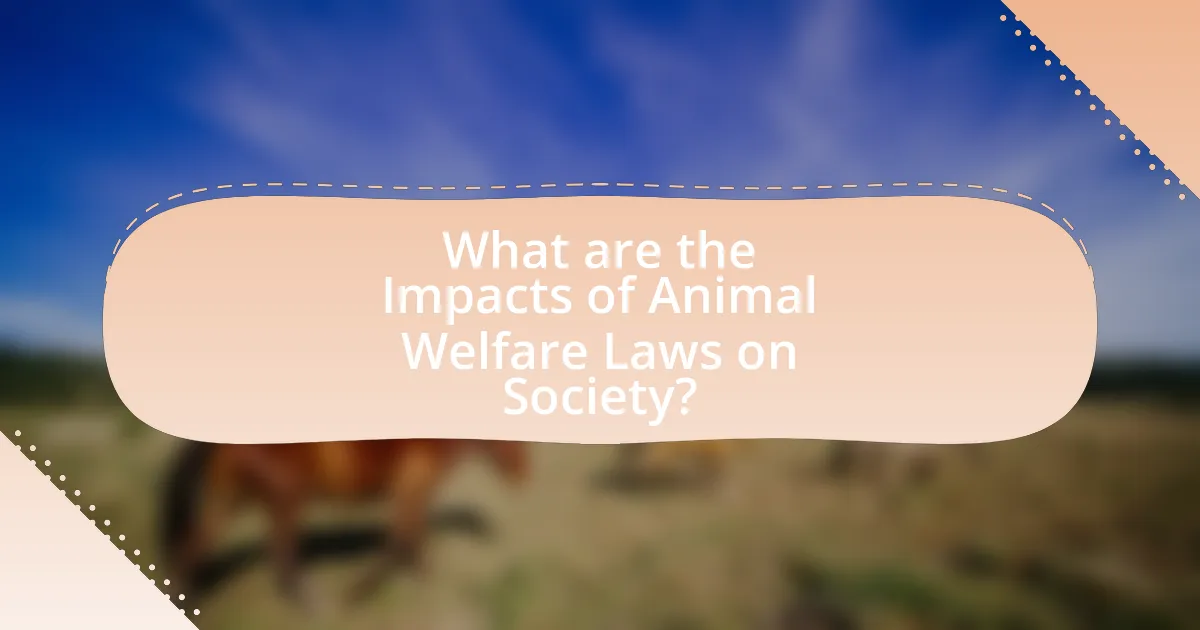Animal welfare laws are regulations aimed at protecting animals from abuse and ensuring humane treatment, with varying standards across countries influenced by cultural, ethical, and legal perspectives. This article analyzes the significance of these laws, their historical contexts, and the challenges faced in enforcement. It explores the impact of animal welfare legislation on society, animal populations, and industries such as agriculture and tourism, while highlighting the role of public awareness and international collaboration in enhancing animal welfare practices. Additionally, it discusses the economic implications of these laws and the importance of advocacy and consumer behavior in driving change.

What are Animal Welfare Laws and Why are They Important?
Animal welfare laws are regulations designed to protect animals from abuse, neglect, and exploitation, ensuring their humane treatment. These laws are important because they establish standards for the care and treatment of animals, which can lead to improved living conditions, reduced suffering, and increased public awareness about animal rights. For instance, the Animal Welfare Act in the United States sets minimum standards for the treatment of animals in research, exhibition, and transport, highlighting the legal obligation to provide adequate care. Such laws not only safeguard animal welfare but also reflect societal values regarding compassion and ethical responsibility towards all living beings.
How do Animal Welfare Laws vary across different countries?
Animal welfare laws vary significantly across different countries, reflecting diverse cultural, ethical, and legal perspectives on animal rights. For instance, countries like Switzerland and Germany have comprehensive animal protection laws that include provisions for the humane treatment of animals, while the United States has a patchwork of state laws with the Animal Welfare Act providing only minimal federal standards. In the European Union, regulations such as the Treaty of Lisbon emphasize animal welfare as a fundamental consideration in agricultural policy, mandating that animals are treated with respect and dignity. Conversely, some countries may lack formal animal welfare legislation altogether, leading to inadequate protections for animals. These variations illustrate how legal frameworks are influenced by societal values, economic factors, and historical contexts regarding animal treatment.
What are the key components of Animal Welfare Laws in various regions?
The key components of Animal Welfare Laws in various regions include provisions for the humane treatment of animals, regulations on animal breeding and sales, and guidelines for the care and housing of animals. For instance, in the European Union, the Treaty of Amsterdam emphasizes animal welfare as a fundamental consideration in agricultural policies, mandating that animals are treated with respect and dignity. In the United States, the Animal Welfare Act sets standards for the treatment of animals in research, exhibition, and transport, ensuring their humane care. Additionally, many regions incorporate penalties for cruelty and neglect, as seen in Canada’s Criminal Code, which includes specific offenses related to animal cruelty. These laws collectively aim to protect animals from suffering and ensure their well-being across different jurisdictions.
How do cultural attitudes influence the development of these laws?
Cultural attitudes significantly influence the development of animal welfare laws by shaping societal values and perceptions regarding the treatment of animals. For instance, in countries where animals are viewed primarily as companions, such as in many Western nations, laws tend to be more protective and comprehensive, reflecting a strong societal commitment to animal rights. Conversely, in cultures where animals are primarily seen as resources or commodities, such as in some agricultural societies, laws may prioritize economic interests over welfare, resulting in less stringent regulations. This correlation is evident in the varying legal frameworks across countries; for example, the European Union has established rigorous animal welfare standards, influenced by a cultural emphasis on ethical treatment, while countries with less emphasis on animal rights may have minimal regulations. Thus, cultural attitudes directly shape the legislative landscape surrounding animal welfare, influencing both the scope and enforcement of laws.
What are the historical contexts of Animal Welfare Laws in different countries?
Animal welfare laws have evolved significantly across different countries, reflecting varying cultural, ethical, and legal perspectives on animal treatment. In the United Kingdom, the Cruelty to Animals Act of 1835 marked one of the first formal legal recognitions of animal welfare, driven by the rise of the animal rights movement and public outcry against animal cruelty. In the United States, the Animal Welfare Act of 1966 established standards for the treatment of animals in research and exhibition, influenced by growing concerns over animal rights and welfare during the 20th century. In Germany, the Animal Protection Act of 1972 was groundbreaking, as it recognized animals as beings with their own needs, influenced by philosophical and ethical considerations regarding animal sentience. Meanwhile, countries like India have a long-standing tradition of animal protection rooted in religious beliefs, with the Prevention of Cruelty to Animals Act of 1960 reflecting these values. These historical contexts illustrate how animal welfare laws are shaped by a combination of social movements, ethical considerations, and cultural values unique to each country.
How have past events shaped current legislation on animal welfare?
Past events have significantly influenced current legislation on animal welfare by highlighting the need for legal protections and ethical treatment of animals. Historical incidents, such as the widespread public outcry following the 1966 Animal Welfare Act in the United States, which was prompted by the mistreatment of animals in research facilities, led to the establishment of more comprehensive laws. Additionally, the rise of animal rights movements in the late 20th century, exemplified by campaigns against factory farming and animal testing, has resulted in stricter regulations and increased public awareness. These movements have driven legislative changes in various countries, leading to the implementation of laws that prioritize animal welfare, such as the European Union’s ban on battery cages for hens in 2012.
What role do international treaties play in national animal welfare laws?
International treaties significantly influence national animal welfare laws by establishing baseline standards and encouraging countries to adopt more comprehensive regulations. For instance, treaties such as the European Convention for the Protection of Animals during International Transport set specific guidelines that member states must incorporate into their national legislation. This alignment often leads to improved animal welfare practices, as countries strive to meet international expectations and commitments. Additionally, international treaties can facilitate cooperation and knowledge sharing among nations, promoting the adoption of best practices in animal welfare.

What are the Impacts of Animal Welfare Laws on Society?
Animal welfare laws significantly impact society by promoting ethical treatment of animals, enhancing public awareness, and influencing consumer behavior. These laws lead to improved living conditions for animals, which in turn fosters a culture of compassion and responsibility among citizens. For instance, countries with stringent animal welfare regulations, such as Sweden and Germany, report higher public engagement in animal rights issues and increased support for humane practices. Additionally, studies indicate that regions with robust animal welfare laws often experience a decline in animal cruelty cases, reflecting a societal shift towards valuing animal rights. This correlation underscores the effectiveness of such laws in shaping societal norms and behaviors regarding animal treatment.
How do these laws affect animal populations and ecosystems?
Animal welfare laws significantly impact animal populations and ecosystems by promoting the protection and conservation of species and their habitats. These laws often lead to reduced exploitation and harm to wildlife, which can enhance biodiversity and stabilize ecosystems. For instance, countries with stringent animal welfare regulations, such as the European Union, have seen improvements in animal health and population recovery for various species, as evidenced by the resurgence of certain bird populations due to habitat protection measures. Additionally, these laws can mitigate the negative effects of human activities, such as poaching and habitat destruction, thereby fostering healthier ecosystems and promoting ecological balance.
What evidence exists to show the impact of these laws on animal welfare?
Evidence shows that animal welfare laws significantly improve the conditions for animals. For instance, a study published in the journal “Animal Welfare” by Mason et al. (2013) found that countries with stringent animal welfare legislation, such as the UK, report lower rates of animal cruelty and better living conditions for farm animals. Additionally, research from the European Commission indicates that the implementation of the Animal Welfare Strategy has led to measurable improvements in animal health and welfare across member states, evidenced by increased compliance rates with welfare standards. These findings demonstrate a clear correlation between robust animal welfare laws and enhanced animal welfare outcomes.
How do Animal Welfare Laws influence public perception of animal rights?
Animal welfare laws significantly shape public perception of animal rights by establishing legal standards that reflect societal values regarding the treatment of animals. These laws often lead to increased awareness and sensitivity towards animal welfare issues, as they highlight the ethical considerations surrounding animal treatment. For instance, countries with robust animal welfare legislation, such as Germany and Switzerland, tend to exhibit higher public support for animal rights initiatives, evidenced by surveys indicating that citizens in these nations prioritize animal welfare in their political and social agendas. This correlation suggests that effective animal welfare laws can foster a culture that values and advocates for the rights of animals, thereby influencing public attitudes and behaviors towards animal rights positively.
What economic impacts arise from implementing Animal Welfare Laws?
Implementing Animal Welfare Laws can lead to both positive and negative economic impacts. On the positive side, these laws can enhance consumer demand for ethically produced animal products, resulting in increased sales for businesses that comply with higher welfare standards. For instance, a study by the European Commission found that 70% of consumers are willing to pay more for products from animals raised under better welfare conditions, which can boost profits for compliant producers. Conversely, the implementation of stringent animal welfare regulations may increase operational costs for farmers and producers due to the need for improved facilities and practices, potentially leading to higher prices for consumers. Research from the Food and Agriculture Organization indicates that compliance costs can range from 5% to 20% of production costs, which can strain smaller producers and affect market competition. Thus, while Animal Welfare Laws can stimulate market growth in ethical sectors, they may also impose financial burdens that could impact overall economic viability in the agricultural sector.
How do these laws affect industries such as agriculture and tourism?
Animal welfare laws significantly impact agriculture and tourism by imposing regulations that affect operational practices and consumer perceptions. In agriculture, these laws often require farmers to adopt more humane treatment of livestock, which can lead to increased production costs due to the need for better facilities and care. For instance, the European Union’s animal welfare regulations mandate specific living conditions for farm animals, which can raise the cost of meat and dairy products.
In tourism, animal welfare laws influence the types of attractions and activities that are permissible, affecting the overall appeal of destinations. Countries with strict animal welfare regulations may limit or ban activities like elephant rides or marine animal shows, which can deter tourists seeking such experiences. Research indicates that destinations promoting ethical tourism practices, aligned with animal welfare, can enhance their attractiveness to a growing segment of conscientious travelers.
Thus, the enforcement of animal welfare laws shapes operational standards in agriculture and alters the landscape of tourism, impacting both economic outcomes and consumer choices.
What are the costs and benefits associated with enforcing these laws?
Enforcing animal welfare laws incurs costs and provides benefits that significantly impact society and animal populations. The costs include financial expenditures for enforcement, such as funding for inspections, legal proceedings, and penalties for non-compliance, which can strain government budgets. For instance, the implementation of stricter animal welfare regulations in the European Union has led to increased operational costs for farmers and businesses due to compliance requirements.
Conversely, the benefits of enforcing these laws include improved animal welfare, which can lead to healthier animal populations and enhanced public health outcomes. Research indicates that better treatment of animals can reduce the spread of zoonotic diseases, thereby benefiting human health. Additionally, enforcing these laws can enhance consumer trust and market demand for ethically sourced animal products, as seen in countries like Sweden, where animal welfare standards have positively influenced consumer behavior and market growth.

What Challenges Exist in Enforcing Animal Welfare Laws?
Enforcing animal welfare laws faces significant challenges, including inadequate funding, lack of trained personnel, and varying legal standards across jurisdictions. In many countries, enforcement agencies are under-resourced, limiting their ability to investigate and prosecute violations effectively. For instance, a report by the World Animal Protection organization highlights that only a small percentage of animal cruelty cases are prosecuted due to insufficient resources and support. Additionally, the inconsistency in laws between regions creates confusion and complicates enforcement efforts, as what is considered acceptable treatment of animals can differ widely. This disparity can lead to loopholes that abusers exploit, undermining the effectiveness of animal welfare legislation.
What are the common obstacles faced by countries in enforcing these laws?
Countries commonly face obstacles such as inadequate funding, lack of public awareness, and insufficient legal frameworks in enforcing animal welfare laws. Inadequate funding limits the resources available for enforcement agencies, hindering their ability to monitor compliance and investigate violations. Lack of public awareness results in low reporting of animal cruelty cases, as citizens may not recognize or understand the laws in place. Additionally, insufficient legal frameworks can lead to vague definitions of animal welfare standards, making it difficult for authorities to take action against offenders. These challenges collectively impede effective enforcement and the overall impact of animal welfare laws.
How do resource limitations affect enforcement efforts?
Resource limitations significantly hinder enforcement efforts in animal welfare laws by reducing the capacity of regulatory agencies to monitor compliance and respond to violations. For instance, insufficient funding can lead to fewer inspectors, limiting the frequency and thoroughness of inspections. According to a report by the World Animal Protection organization, countries with limited resources often struggle to implement and enforce animal welfare legislation effectively, resulting in higher rates of animal cruelty and neglect. This correlation between resource availability and enforcement efficacy underscores the critical need for adequate funding and staffing to ensure that animal welfare laws are upheld.
What role does public awareness play in the effectiveness of these laws?
Public awareness significantly enhances the effectiveness of animal welfare laws by fostering community engagement and compliance. When the public is informed about animal rights and welfare issues, they are more likely to support and advocate for stringent enforcement of these laws. For instance, studies have shown that countries with higher public awareness regarding animal welfare, such as Sweden and Germany, tend to have more robust legal frameworks and better enforcement outcomes. This correlation indicates that informed citizens can influence policymakers and contribute to a culture of accountability, ultimately leading to improved animal welfare standards.
How do different countries address violations of Animal Welfare Laws?
Different countries address violations of Animal Welfare Laws through a combination of legislation, enforcement mechanisms, and penalties. For instance, in the United Kingdom, the Animal Welfare Act 2006 provides a legal framework for the protection of animals, allowing authorities to impose fines and imprisonment for violations. In contrast, the United States has a patchwork of state laws and the Animal Welfare Act of 1966, which primarily regulates the treatment of animals in research and exhibition, leading to varying enforcement levels across states. Countries like Germany have stringent laws that include mandatory reporting of animal cruelty, while others may lack comprehensive legal frameworks, resulting in minimal penalties for offenders. These differences highlight the varying approaches to animal welfare enforcement globally, influenced by cultural, legal, and political factors.
What penalties are typically imposed for non-compliance?
Penalties for non-compliance with animal welfare laws typically include fines, imprisonment, and the revocation of licenses or permits. For instance, in the United States, the Animal Welfare Act allows for fines up to $10,000 per violation and imprisonment for up to one year for serious offenses. In the European Union, non-compliance can result in fines and sanctions imposed by member states, with some countries enforcing penalties that can reach several thousand euros. These penalties are designed to deter violations and ensure adherence to established animal welfare standards.
How effective are these penalties in deterring future violations?
Penalties for animal welfare violations are effective in deterring future violations, as evidenced by a reduction in reported offenses following the implementation of stricter laws. For instance, countries like Germany and the Netherlands, which have enforced stringent penalties, have seen a significant decrease in animal cruelty cases, with reports indicating a drop of up to 30% in such incidents within the first few years of enforcement. This correlation suggests that the presence of severe penalties acts as a deterrent, encouraging compliance with animal welfare standards.

What Best Practices Can Enhance Animal Welfare Legislation?
Best practices that can enhance animal welfare legislation include establishing clear legal definitions of animal welfare, implementing regular inspections and enforcement mechanisms, and promoting public awareness and education on animal rights. Clear legal definitions ensure that laws are specific and enforceable, reducing ambiguity in interpretation. Regular inspections and enforcement mechanisms, such as penalties for non-compliance, ensure that animal welfare standards are upheld, as evidenced by countries like Germany, which has stringent enforcement practices leading to improved animal conditions. Public awareness campaigns can foster a culture of compassion and responsibility towards animals, as seen in the UK, where educational initiatives have significantly increased public support for animal welfare laws.
How can countries learn from each other’s Animal Welfare Laws?
Countries can learn from each other’s Animal Welfare Laws by analyzing successful legislative frameworks and their outcomes. For instance, the European Union’s comprehensive animal welfare regulations have led to improved standards across member states, demonstrating the effectiveness of collaborative policy-making. Additionally, countries can share data on the impact of specific laws, such as the reduction in animal cruelty cases following the implementation of stricter regulations in countries like Germany. By engaging in international forums and adopting best practices, nations can enhance their own animal welfare standards, ultimately benefiting animal populations globally.
What successful case studies exist in the realm of animal welfare?
Successful case studies in the realm of animal welfare include the implementation of the Animal Welfare Act in the United States, which has led to improved living conditions for millions of animals in research facilities and zoos. This legislation, enacted in 1966, mandates humane treatment and care standards, resulting in a significant reduction in animal suffering. Another notable case is the ban on battery cages for hens in the European Union, which took effect in 2012, improving the welfare of over 300 million hens by allowing them more space and natural behaviors. Additionally, the “No Kill” movement in various U.S. cities, such as San Francisco, has successfully reduced euthanasia rates in animal shelters by promoting adoption and community engagement, demonstrating effective strategies for animal welfare enhancement. These examples illustrate the positive impact of comprehensive animal welfare laws and initiatives across different regions.
How can collaboration between nations improve animal welfare globally?
Collaboration between nations can significantly improve animal welfare globally by establishing unified standards and sharing best practices. When countries work together, they can create comprehensive frameworks that address issues such as factory farming, animal testing, and wildlife conservation. For instance, the World Organisation for Animal Health (OIE) sets international standards for animal health and welfare, which member countries can adopt to enhance their own regulations. This collaboration leads to better enforcement of animal welfare laws, as seen in the European Union’s efforts to harmonize animal welfare legislation across its member states, resulting in improved conditions for millions of animals. Additionally, joint research initiatives can provide valuable data on animal welfare practices, enabling countries to learn from each other’s successes and failures.
What practical steps can individuals take to support Animal Welfare Laws?
Individuals can support Animal Welfare Laws by actively participating in advocacy efforts, such as signing petitions and contacting legislators to express their support for stronger animal protection measures. Engaging in community awareness campaigns helps educate others about the importance of animal welfare, which can lead to increased public support for relevant laws. Additionally, volunteering with local animal shelters or welfare organizations provides direct assistance to animals in need and strengthens the community’s commitment to animal rights. According to a 2021 survey by the American Society for the Prevention of Cruelty to Animals, 70% of respondents indicated they would support animal welfare legislation if they were informed about its benefits, demonstrating the impact of individual advocacy on legislative change.
How can advocacy and education contribute to better animal welfare?
Advocacy and education significantly enhance animal welfare by raising awareness and promoting humane treatment practices. Advocacy efforts, such as campaigns and lobbying, influence policymakers to enact and enforce stronger animal welfare laws, as seen in countries like Germany, where public pressure led to the implementation of comprehensive animal protection legislation. Education initiatives inform the public about the needs and rights of animals, fostering empathy and responsible ownership, which is evidenced by programs in the United States that have reduced pet abandonment rates through community outreach and training. Together, these strategies create a more informed society that prioritizes animal welfare, leading to improved conditions for animals globally.
What role do consumers play in influencing animal welfare practices?
Consumers play a crucial role in influencing animal welfare practices by driving demand for ethically produced products. Their purchasing choices can compel companies to adopt higher welfare standards, as evidenced by the rise in sales of cage-free eggs, which increased by 50% in the U.S. from 2015 to 2020, reflecting consumer preference for humane treatment of animals. Additionally, consumer advocacy and awareness campaigns have led to legislative changes, such as California’s Proposition 12, which sets strict animal housing standards, demonstrating that consumer pressure can result in significant shifts in animal welfare laws.